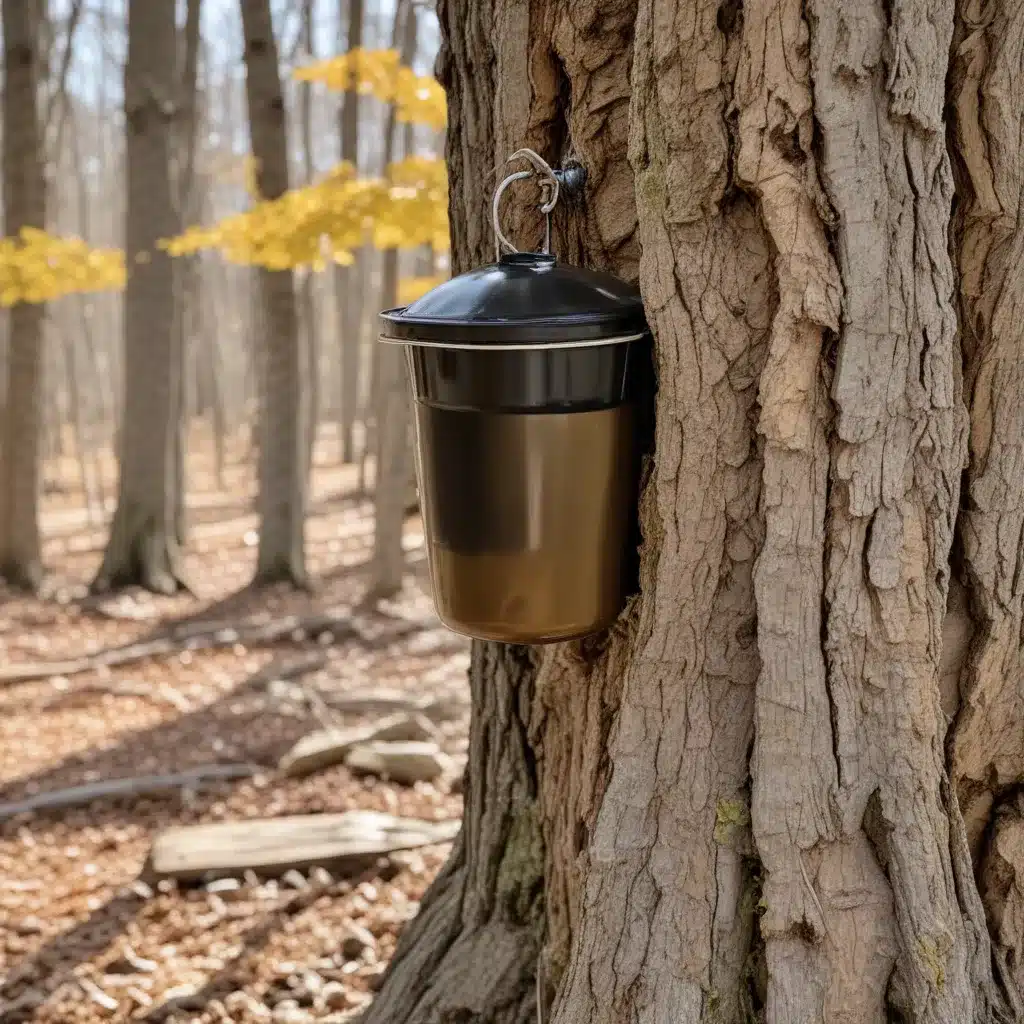
The Maple Tree’s Awakening
As winter’s icy grip slowly loosens, a sure sign of spring’s approach arrives in the form of maple trees stirring to life. These stately hardwoods, with their distinctive fan-shaped leaves, silently prepare to unleash their precious sap – a sugary elixir that has sustained human populations for centuries. At Crooked Pines Farm, we eagerly await this annual rite of passage, when the rhythmic cycle of freezing nights and warming days sets the stage for our maple sugaring season.
The Sap Collection Process
The maple’s sap flow is triggered by fluctuating temperatures, as freezing nighttime conditions give way to thawing daytime warmth. This freeze-thaw cycle creates internal pressure within the tree, forcing the dilute, sugar-laden sap upwards from the roots towards the branches. It is this sap, with its natural concentration of 2-3% sucrose, that maple enthusiasts eagerly tap into using specialized spiles (or taps) driven gently into the tree’s bark.
In days past, sap was collected in quaint buckets hung from each tapped tree. Today, many producers employ an intricate network of plastic tubing to channel the sap flow more efficiently to a central sugar house. Here, the real magic begins, as the sap undergoes a remarkable transformation.
The Transformation of Sap to Syrup
Inside the sugar house, the sap is poured into a specialized evaporator – a large, shallow pan heated by a roaring wood fire. As the sap heats, its water content steadily evaporates, leaving behind an increasingly concentrated syrup. This painstaking process, which can take 40 gallons of sap to produce just a single gallon of finished maple syrup, is what gives the final product its coveted deep amber hue and rich, buttery flavor.
The Seasonal Cycle
Preparing for Spring
At Crooked Pines, our maple sugaring season kicks into high gear in late winter, as our farm crew gets to work tapping trees and readying the sugar house. We carefully inspect each maple, ensuring they are of suitable size and health to support the tapping process without causing harm. With taps in place and tubing networks installed, we eagerly await the first signs of sap flow.
The Sap’s Journey
As daytime temperatures climb above freezing, the sap begins its journey upwards, driven by the internal pressure of the thawing trees. We listen intently for the telltale drip-drip of sap filling our collection buckets and tanks, a sound that signals the start of our precious harvest. The sap is then transported to the sugar house, where the real magic unfolds.
The Harvest Celebration
The boiling and concentration of maple sap is a time-honored tradition at Crooked Pines, filled with the rich aroma of wood smoke and the satisfying hiss of steaming sap. Families and visitors often gather around the sugar house, sharing in the excitement of the season and the pride of crafting small-batch maple syrup. It’s a celebration of nature’s bounty and the enduring connection between people and the land.
The Culinary Delights
Maple Syrup Varieties
Not all maple syrups are created equal. As the season progresses, the sap’s flavor and color can shift, resulting in a range of unique maple syrup grades. Early-season syrups are often lighter, more delicate, and possess a subtle sweetness, while late-season offerings tend to be darker and more robust in maple essence. At Crooked Pines, we take great care to carefully grade and bottle each batch, ensuring our customers can explore the full spectrum of maple’s culinary magic.
Maple-Infused Recipes
The versatility of maple syrup extends well beyond the breakfast table. At our farm, we love to incorporate this natural sweetener into a variety of savory and sweet dishes. Try drizzling maple over roasted root vegetables, whisking it into salad dressings, or using it as a glaze for pork or salmon. For a true taste of spring, few things can rival the simple pleasure of maple syrup poured over a stack of fluffy pancakes or waffles.
The Art of Maple Candy
As the season reaches its peak, the sap becomes increasingly concentrated, allowing us to push the boundaries of maple’s culinary potential. By boiling the syrup to an even greater degree, we can craft delightful maple candies and creams – confections that capture the essence of the maple tree in a compact, portable form. Whether enjoyed on their own or used to top ice cream, yogurt, or baked goods, these maple-based treats are a genuine taste of springtime.
The Cultural Significance
Maple’s Indigenous Roots
The tradition of maple sugaring has deep roots in the Indigenous cultures of the Northeastern United States and Canada. For centuries, the region’s native peoples, such as the Abenaki, Mohawk, and Ojibwe, have tapped maple trees and used the sap to create an array of sweet delicacies. At Crooked Pines, we honor this rich heritage by incorporating traditional methods and wisdom into our own maple sugaring practices.
The Maple Sugaring Community
Maple sugaring is a beloved community event at Crooked Pines, one that brings together neighbors, families, and visitors from near and far. Each spring, we open our sugar house to the public, hosting demonstrations, tastings, and educational programs that celebrate the art and science of this age-old craft. It’s a time to share stories, learn new skills, and forge connections with the land and each other.
The Maple Legacy Endures
As the seasons turn and the years pass, the maple tree’s annual sap flow remains a constant in the lives of those who call the Northeast home. At Crooked Pines, we take great pride in our role as stewards of this beloved tradition, ensuring that the sweet legacy of maple sugaring continues to thrive for generations to come. Whether enjoyed as a breakfast staple, a culinary ingredient, or a cherished memento, the maple syrup that flows from our farm is a testament to the enduring bond between people, nature, and the changing of the seasons.


